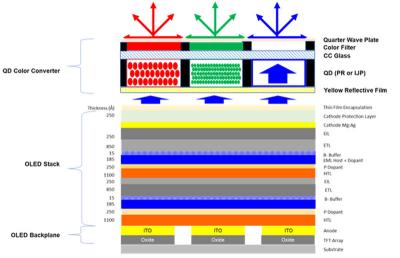In October 2019 Samsung Display formally announced its decision to invest $10.85 billion in QD-OLED TV R&D and production lines. SDC was supposed to start the plan in 2019, but according to a report from China the Company is delaying its initial investment. Originally mass production was supposed to begin in Q1 2021, but this may happen later if the investment is delayed.
It seems as if equipment makers expected to receive orders for production equipment, but that did not happen. The report says that Samsung decided to make personnel changes and transfer in January 2020 and only after these changes will the company finalize its investment plan in the new OLED TV fab.
According to the original plan, the building of SDC's QD-OLED fab will span 6 years (2019-2025) and the first step will be to convert an LCD production line in SDC's L8 fab in Tangjong, Korea to QD-OLED production. The Tangjong line will be converted from 125k monthly substrates of LCD production to 30k monthly QD-OLED substrates.
In the long run SDC plans to convert all its 8-Gen LCD lines (360,000 monthly substrates) to QD-OLED production (which will yield around 100,000 monthly QD-OLED substrates).

According to DSCC, Samsung's QD-OLEDs will offer several advantages compared to LG's current WRGB (four subpixels + color filters) system. Samsung will be able to use three sub pixels and only two emitting layers (LGD uses four), and so its stack will include 13 layers compared to 22 layers in LGD's TVs - which means fewer deposition stages, improved yields and lower material costs.
In fact, DSCC estimates that a square meter of QD-OLED production will require materials that cost around $26 - compared to almost $95 in a meter of WOLED production.

You can see DSCC's QD-OLED revenue forecast here - although they admit that as Samsung faces several technical challenges before it could launch commercial QD-OLED TVs, its forecast could be way off.
The two main challenges for QD-OLEDs, according to DSCC, are efficient blue OLED emitters (first-gen will likely use fluorescent emitters) and a good quantum-dot color converter (QDCC). Light management in this architecture is also a serious challenge.

